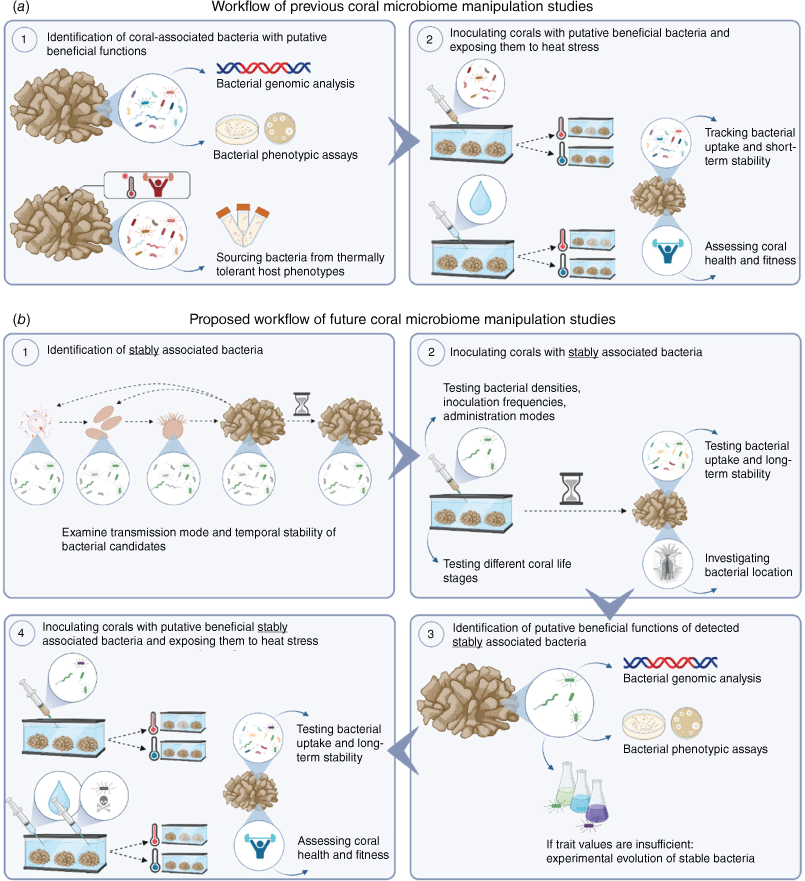Advancing coral microbiome manipulation to build long-term climate resilience
Talisa Doering A * , Justin Maire A , Madeleine J. H. van Oppen A B and Linda L. Blackall AA School of BioSciences, The University of Melbourne, Parkville, Vic., Australia.
B Australian Institute of Marine Science, Townsville, Qld, Australia.

Talisa Doering is currently a PhD student at the University of Melbourne, supervised by Prof. Madeleine J. H. van Oppen and Prof. Linda L. Blackall. She completed her Bachelor of Science degree in Biology at the Free University of Berlin, studying evolution of marine fishes to climate change regimes. She obtained her Master of Science degree in Biological Oceanography at Kiel University and GEOMAR Helmholtz Centre for Ocean Research Kiel, where she conducted a coral microbiome transplant experiment from heat-sensitive to heat-tolerant coral conspecifics in order to build coral climate resilience. Her current PhD research focuses on understanding coral bleaching mechanisms, identifying beneficial coral-associated bacteria and developing successful microbiome-manipulation approaches that can enhance coral bleaching resilience. |

Dr Justin Maire is currently a postdoctoral fellow at the University of Melbourne. He obtained his PhD in 2018 from Institut National des Sciences Appliquées de Lyon, France, on symbiotic interactions between insects and bacteria and their impact on host immunity and development. In 2019, he moved to the University of Melbourne, where his research is focused on coral–bacteria associations. He specifically focuses on closely associated symbionts, e.g. intracellular, vertically transmitted symbionts, and their potential use as bacterial probiotics and microbiome engineering as an approach for the mitigation of coral bleaching and coral reef conservation. This includes characterising the taxonomy, localisation and functions of symbionts of interests. |

Prof. Madeleine J. H. van Oppen is an ecological geneticist with an interest in microbial symbioses and climate change adaptation of reef corals. Her early career focused on evolutionary and population genetics of algae and fish, and subsequently corals. Currently, her team is using bioengineering approaches aimed at increasing coral climate resilience and the likelihood that coral reefs will survive this century. These interventions include coral host hybridisation and conditioning, directed evolution of microalgal symbionts and bacterial probiotics. |

Prof. Linda L. Blackall is an environmental microbial ecologist, who has studied many different complex microbial communities ranging from host associated through to free living in numerous environments. One of her research fields is the microbiota of corals and sponges. The numerous methods she develops and employs in her research allow elucidation of microbial complexity and function in these diverse biomes. |
Microbiology Australia 44(1) 36-40 https://doi.org/10.1071/MA23009
Submitted: 15 January 2023 Accepted: 1 March 2023 Published: 9 March 2023
© 2023 The Author(s) (or their employer(s)). Published by CSIRO Publishing on behalf of the ASM. This is an open access article distributed under the Creative Commons Attribution-NonCommercial-NoDerivatives 4.0 International License (CC BY-NC-ND)
Abstract
Coral reefs house one-third of all marine species and are of high cultural and socioeconomic importance. However, coral reefs are under dire threat from climate change and other anthropogenic stressors. Climate change is causing coral bleaching, the breakdown of the symbiosis between the coral host and its algal symbionts, often resulting in coral mortality and the deterioration of these valuable ecosystems. While it is essential to counteract the root causes of climate change, it remains urgent to develop coral restoration and conservation methods that will buy time for coral reefs. The manipulation of the bacterial microbiome that is associated with corals has been suggested as one intervention to improve coral climate resilience. Early coral microbiome-manipulation studies, which are aimed at enhancing bleaching tolerance, have shown promising results, but the inoculated bacteria did generally not persist within the coral microbiome. Here, we highlight the importance of long-term incorporation of bacterial inocula into the microbiome of target corals, as repeated inoculations will be too costly and not feasible on large reef systems like the Great Barrier Reef. Therefore, coral microbiome-manipulation studies need to prioritise approaches that can provide sustained coral climate resilience.
Keywords: assisted evolution, coral bleaching, coral microbiome, microbiome manipulation, probiotics.
The threat of climate change to coral reefs
Tropical coral reefs are biodiversity hotspots, protect our coastlines from floods and storms, are socioeconomically important because they provide employment and support several industries, and have high cultural and spiritual value. However, tropical coral reefs are disappearing due to the impacts of climate change, which is causing a gradual increase in sea surface temperatures (SSTs), and also an increase in the frequency, intensity and duration of summer heatwaves. Higher-than-usual SSTs in combination with high irradiance levels, which often occur during these extreme summer events, are the main cause of mass coral bleaching.1 Coral bleaching is the loss of dinoflagellate photosymbionts (Symbiodiniaceae family) from coral tissues. Since Symbiodiniaceae provide corals with most of their energy, bleaching is often followed by coral starvation and death, and reef degradation.2 On the Great Barrier Reef (GBR), seven large-scale bleaching events have occurred since 1998, and <2% of the GBR has never bleached.3 Effective bleaching mitigation and restoration approaches that will buy time for coral reefs until global warming is curbed are therefore urgently required. Accelerating evolutionary processes to enhance coral bleaching resilience through assisted evolution4 is being explored as one option, which includes the manipulation of the coral bacterial microbiome.5
The coral host together with its associated microorganisms, including bacteria, archaea, Symbiodiniaceae and other protists, viruses and fungi,6 are referred to as the coral holobiont. Coral-associated bacteria are diverse and believed to play important roles for the holobiont such as cycling nutrients,7 producing essential vitamins and amino acids, regulating the bacterial community and warding off pathogens.8 The composition of coral-associated bacterial communities is sometimes correlated with heat tolerance of the coral host,9 suggesting a bacterial role in the coral heat stress response.
There are currently three hypotheses that explain the cellular mechanisms underpinning coral bleaching. The oxidative stress theory posits that high SSTs and irradiance impair the Symbiodiniaceae photosystem, triggering an overproduction of toxic reactive oxygen species (ROS) that leak into coral cells where they cause a cellular cascade that results in the separation of Symbiodiniaceae from the host.10 The second hypothesis suggests bleaching is triggered by an accumulation of ROS and damage to the Calvin–Benson–Bassham cycle, due to the host not meeting the CO2 demands for the faster-growing algal endosymbionts under elevated temperatures.11 The third hypothesis poses that heat stress heightens host catabolism, which increases available ammonium for Symbiodiniaceae, fuelling algal growth and carbon usage.12 This results in carbon limitation of the host and phosphorus limitation of Symbiodiniaceae, causing damage to the algal photosystem and its membranes13 and, again, leading to the overproduction of ROS, which triggers bleaching. Thus, potentially relevant bacterial traits for microbiome manipulation to boost thermal bleaching resilience include the neutralisation of ROS by antioxidants or the supply of carbon to the host to minimise its starvation.
Microbiome manipulation as a tool to enhance coral climate resilience
Here, we define microbiome manipulation as the directed alteration of the microbiome by humans, with the overall goal to provide host health benefits. This can be achieved by approaches such as probiotics or the transplantation of microbial communities. Microbiome manipulation is a common approach in medicine, including, for instance, the use of fecal microbiome transplantation to treat Clostridium infections.14 However, microbiome manipulation in corals is still at an early stage. Generally, its feasibility has been demonstrated by showing that the composition of coral-associated bacterial communities can be modified through bacterial inoculation.15 Initial coral microbiome-manipulation studies have focussed on disease treatment, such as white pox disease,16 or on the bioremediation of oil pollution.17 Recent microbiome-manipulation studies to enhance coral bleaching resilience are promising, although clear correlations between the presence or abundance of inoculated bacteria and coral bleaching tolerance have not been proven yet. One study determined that bacteria isolated from corals and surrounding seawater had putative beneficial functions such as antagonistic activity against a common coral pathogen, activity of the ROS-scavenging enzyme catalase, and potentially contributed to sulfur and nitrogen cycling (by determining the presence of genes involved in the pathways).18 Inoculating the coral Pocillopora damicornis with this bacterial cocktail partially inhibited thermal coral bleaching and pathogen infection.18 A similar study selected candidate probiotic bacteria from Mussismilia hispida by screening for the same attributes as above, and showed that administering the probiotic mix to M. hispida reduced bleaching and improved recovery after thermal stress.19 An additional study showed short-term bleaching mitigation of previously heat-sensitive corals after they were inoculated with a microbiome obtained from heat-tolerant corals from the same species.20 Even though all three studies applied no-inoculum controls, increased bleaching tolerance might stem from the bacterial cocktail acting as a source of nutrition for the coral host growing heterotrophically. Integrating non-beneficial or dead bacteria as an additional negative control that might act as a food source without providing any other benefits may help decipher the impact of heterotrophic feeding v. microbiome manipulation on thermal tolerance. A recent study inoculated the coral model sea anemone Exaiptasia diaphana with either a consortium of bacterial strains with high ROS-scavenging abilities, a negative control that contained closely related bacterial strains with no ROS-scavenging abilities (to control for the effect of heterotrophic feeding), or a no-inoculum control.21 The inoculated bacteria were lost from the E. diaphana host prior to heat stress application precluding any conclusions on their impact on bleaching resilience to be drawn.
Overall, these studies showed limited and short-term uptake of some of the inoculated bacteria,20,21 or restructuring of the bacterial community composition following inoculation.18,19 However, no study has demonstrated long-term uptake and temporal stability of the inoculated bacteria, although divergent microbiome communities were observed in coral juveniles 4 months after a single microbiome transplant from each of four different species of adult corals, including one adult coral that was conspecific to the larval recipients.15 To provide long-term benefits and to create a sustainable solution to build coral bleaching resilience, putative beneficial coral bacteria need to form a temporally stable association with the coral host, thereby limiting the need for repeated inoculations across vast geographical scales.
Using stably associated bacteria for long-term benefits
Several aspects need to be considered to ensure uptake and persistence of inoculated bacteria by the host to guarantee long-term beneficial effects on holobiont performance (Fig. 1). First, we recommend focussing on bacteria that are stably associated with the host. Although corals associate with a high portion of ephemeral bacteria, there is a smaller portion that forms a more temporally stable symbiosis with the coral host.22 Stable members of the coral microbiome are more likely to be found in the coral tissues,23 where some are described to form bacterial aggregates,24 and sometimes they are vertically transmitted to coral offspring. A successful example from another biological system is the use of the vertically transmitted, intracellular bacterium Wolbachia to reduce the spread of the viral disease, dengue. When introduced into Aedes aegypti mosquitoes, Wolbachia provides arboviral protection to mosquito hosts and spreads quickly and efficiently through wild populations following the release of infected mosquitoes, without the need for further intervention.25 This is despite A. aegypti not being a natural host for Wolbachia. Therefore, temporal stability of bacteria within the host microbiome should be studied over longer timescales (e.g. months and longer), as most previous experiments have tested a duration of 24 h,20 5,19 1118 and 35 days,21 except for one study testing over 4 months,5 and over multiple generations.
Second, we propose to source bacteria from coral microhabitats where beneficial functions are required. One of the key mechanisms in bleaching involves the overproduction of ROS by Symbiodiniaceace in host gastrodermal cells. Therefore, ROS-scavenging bacteria that closely associate with Symbiodiniaceae or are present in the gastrodermis would be relevant. Some bacteria co-localise with Symbiodiniaceae in culture and in hospite26,27 and may play a role in Symbiodiniaceae and coral health.28
Once stable members from coral microhabitats are identified, the next critical step for candidate selection will be to understand their functions, especially with regards to coral bleaching and climate resilience. This can be achieved through genomic analyses and phenotypic assays. If candidates of interest exhibit limited functional ability, such as low ROS-scavenging abilities, laboratory evolution experiments may be used to enhance their abilities, for example through long-term exposure to oxidative stress conditions.29
In summary, the selection of bacterial candidates based on their temporal stability and location within the coral holobiont, followed by their bleaching mitigation functions are critical steps in developing microbiome-manipulation techniques that aim to build long-term bleaching resilience. Since recent models predict that environmental conditions will become unsuitable for coral reefs by 2035,30 the next decade will be crucial to curb greenhouse gas emissions and develop effective and sustainable conservation methods to buy time for corals.
Data availability
Data sharing is not applicable as no new data were generated or analysed during this study.
Conflicts of interest
The authors declare that they have no conflicts of interest.
Declaration of funding
This research was funded by the by the Australian Research Council Laureate Fellowship FL180100036 to M. J. H. van Oppen. T. Doering was supported by a University of Melbourne Scholarship by the Environmental Microbiology Research Initiative.
References
[1] Hoegh-Guldberg, O (1999) Climate change, coral bleaching and the future of the world’s coral reefs. Mar Freshw Res 50, 839–866.| Climate change, coral bleaching and the future of the world’s coral reefs.Crossref | GoogleScholarGoogle Scholar |
[2] Suggett, DJ and Smith, DJ (2020) Coral bleaching patterns are the outcome of complex biological and environmental networking. Glob Chang Biol 26, 68–79.
| Coral bleaching patterns are the outcome of complex biological and environmental networking.Crossref | GoogleScholarGoogle Scholar |
[3] Hughes, TP et al. (2021) Emergent properties in the responses of tropical corals to recurrent climate extremes. Curr Biol 31, 5393–5399.e3.
| Emergent properties in the responses of tropical corals to recurrent climate extremes.Crossref | GoogleScholarGoogle Scholar |
[4] van Oppen, MJH et al. (2015) Building coral reef resilience through assisted evolution. Proc Natl Acad Sci USA 112, 2307–2313.
| Building coral reef resilience through assisted evolution.Crossref | GoogleScholarGoogle Scholar |
[5] Damjanovic, K et al. (2017) The contribution of microbial biotechnology to mitigating coral reef degradation. Microb Biotechnol 10, 1236–1243.
| The contribution of microbial biotechnology to mitigating coral reef degradation.Crossref | GoogleScholarGoogle Scholar |
[6] Blackall, LL et al. (2015) Coral-the world’s most diverse symbiotic ecosystem. Mol Ecol 24, 5330–5347.
| Coral-the world’s most diverse symbiotic ecosystem.Crossref | GoogleScholarGoogle Scholar |
[7] Bourne, DG et al. (2016) Insights into the coral microbiome: underpinning the health and resilience of reef ecosystems. Annu Rev Microbiol 70, 317–340.
| Insights into the coral microbiome: underpinning the health and resilience of reef ecosystems.Crossref | GoogleScholarGoogle Scholar |
[8] Ritchie, KB (2006) Regulation of microbial populations by coral surface mucus and mucus-associated bacteria. Mar Ecol Prog Ser 322, 1–14.
| Regulation of microbial populations by coral surface mucus and mucus-associated bacteria.Crossref | GoogleScholarGoogle Scholar |
[9] Ziegler, M et al. (2017) Bacterial community dynamics are linked to patterns of coral heat tolerance. Nat Commun 8, 14213.
| Bacterial community dynamics are linked to patterns of coral heat tolerance.Crossref | GoogleScholarGoogle Scholar |
[10] Oakley CA, Davy SK (2018) Cell biology of coral bleaching. In Coral Bleaching (van Oppen M, Lough J, eds). pp. 189–211. Springer International Publishing.
[11] Wooldridge, SA (2013) Breakdown of the coral-algae symbiosis: towards formalising a linkage between warm-water bleaching thresholds and the growth rate of the intracellular zooxanthellae. Biogeosciences 10, 1647–1658.
| Breakdown of the coral-algae symbiosis: towards formalising a linkage between warm-water bleaching thresholds and the growth rate of the intracellular zooxanthellae.Crossref | GoogleScholarGoogle Scholar |
[12] Rädecker, N et al. (2021) Heat stress destabilizes symbiotic nutrient cycling in corals. Proc Natl Acad Sci USA 118, e2022653118.
| Heat stress destabilizes symbiotic nutrient cycling in corals.Crossref | GoogleScholarGoogle Scholar |
[13] Wiedenmann, J et al. (2013) Nutrient enrichment can increase the susceptibility of reef corals to bleaching. Nat Clim Chang 3, 160–164.
| Nutrient enrichment can increase the susceptibility of reef corals to bleaching.Crossref | GoogleScholarGoogle Scholar |
[14] Harkins, CP et al. (2020) Manipulating the human microbiome to manage disease. JAMA 323, 303–304.
| Manipulating the human microbiome to manage disease.Crossref | GoogleScholarGoogle Scholar |
[15] Damjanovic, K et al. (2019) Experimental inoculation of coral recruits with marine bacteria indicates scope for microbiome manipulation in Acropora tenuis and Platygyra daedalea. Front Microbiol 10, 1702.
| Experimental inoculation of coral recruits with marine bacteria indicates scope for microbiome manipulation in Acropora tenuis and Platygyra daedalea.Crossref | GoogleScholarGoogle Scholar |
[16] Alagely, A et al. (2011) Signaling-mediated cross-talk modulates swarming and biofilm formation in a coral pathogen Serratia marcescens. ISME J 5, 1609–1620.
| Signaling-mediated cross-talk modulates swarming and biofilm formation in a coral pathogen Serratia marcescens.Crossref | GoogleScholarGoogle Scholar |
[17] dos Santos, HF et al. (2015) Impact of oil spills on coral reefs can be reduced by bioremediation using probiotic microbiota. Sci Rep 5, 18268.
| Impact of oil spills on coral reefs can be reduced by bioremediation using probiotic microbiota.Crossref | GoogleScholarGoogle Scholar |
[18] Rosado, PM et al. (2019) Marine probiotics: increasing coral resistance to bleaching through microbiome manipulation. ISME J 13, 921–936.
| Marine probiotics: increasing coral resistance to bleaching through microbiome manipulation.Crossref | GoogleScholarGoogle Scholar |
[19] Santoro, EP et al. (2021) Coral microbiome manipulation elicits metabolic and genetic restructuring to mitigate heat stress and evade mortality. Sci Adv 7, 19–21.
| Coral microbiome manipulation elicits metabolic and genetic restructuring to mitigate heat stress and evade mortality.Crossref | GoogleScholarGoogle Scholar |
[20] Doering, T et al. (2021) Towards enhancing coral heat tolerance : a “microbiome transplantation” treatment using inoculations of homogenized coral tissues. Microbiome 9, 102.
| Towards enhancing coral heat tolerance : a “microbiome transplantation” treatment using inoculations of homogenized coral tissues.Crossref | GoogleScholarGoogle Scholar |
[21] Dungan, AM et al. (2022) Exploring microbiome engineering as a strategy for improved thermal tolerance in Exaiptasia diaphana. J Appl Microbiol 132, 2940–2956.
| Exploring microbiome engineering as a strategy for improved thermal tolerance in Exaiptasia diaphana.Crossref | GoogleScholarGoogle Scholar |
[22] Hernandez-Agreda, A et al. (2016) The microbial signature provides insight into the mechanistic basis of coral success across reef habitats. MBio 7, e00560-16.
| The microbial signature provides insight into the mechanistic basis of coral success across reef habitats.Crossref | GoogleScholarGoogle Scholar |
[23] Maire, J et al. (2021) Intracellular bacterial symbionts in corals: challenges and future directions. Microorganisms 9, 2209.
| Intracellular bacterial symbionts in corals: challenges and future directions.Crossref | GoogleScholarGoogle Scholar |
[24] Work, TM and Aeby, GS (2014) Microbial aggregates within tissues infect a diversity of corals throughout the Indo-Pacific. Mar Ecol Prog Ser 500, 1–9.
| Microbial aggregates within tissues infect a diversity of corals throughout the Indo-Pacific.Crossref | GoogleScholarGoogle Scholar |
[25] Flores, HA and O’Neill, SL (2018) Controlling vector-borne diseases by releasing modified mosquitoes. Nat Rev Microbiol 16, 508–518.
| Controlling vector-borne diseases by releasing modified mosquitoes.Crossref | GoogleScholarGoogle Scholar |
[26] Frommlet, JC et al. (2015) Coral symbiotic algae calcify ex hospite in partnership with bacteria. Proc Natl Acad Sci USA 112, 6158–6163.
| Coral symbiotic algae calcify ex hospite in partnership with bacteria.Crossref | GoogleScholarGoogle Scholar |
[27] Maire, J et al. (2021) Intracellular bacteria are common and taxonomically diverse in cultured and in hospite algal endosymbionts of coral reefs. ISME J 15, 2028–2042.
| Intracellular bacteria are common and taxonomically diverse in cultured and in hospite algal endosymbionts of coral reefs.Crossref | GoogleScholarGoogle Scholar |
[28] Motone, K et al. (2020) A zeaxanthin-producing bacterium isolated from the algal phycosphere protects coral endosymbionts from environmental stress. mBio 11, e01019-19.
| A zeaxanthin-producing bacterium isolated from the algal phycosphere protects coral endosymbionts from environmental stress.Crossref | GoogleScholarGoogle Scholar |
[29] Maire, J and van Oppen, MJH (2022) A role for bacterial experimental evolution in coral bleaching mitigation? Trends Microbiol 30, 217–228.
| A role for bacterial experimental evolution in coral bleaching mitigation?Crossref | GoogleScholarGoogle Scholar |
[30] Setter, RO et al. (2022) Co-occurring anthropogenic stressors reduce the timeframe of environmental viability for the world’s coral reefs. PLoS Biol 20, e3001821.
| Co-occurring anthropogenic stressors reduce the timeframe of environmental viability for the world’s coral reefs.Crossref | GoogleScholarGoogle Scholar |



